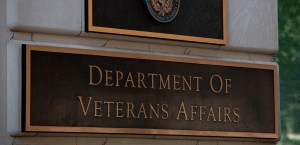 Richard B. Radichel, deputy director, Systems Management Division, Dept. of Veterans Affairs (center) at the Adobe Digital Government Assembly, Feb. 6, 2014. (Photo: FedScoop)
Richard B. Radichel, deputy director, Systems Management Division, Dept. of Veterans Affairs (center) at the Adobe Digital Government Assembly, Feb. 6, 2014. (Photo: FedScoop)For the Department of Veterans Affairs, good news on the information technology front can often seem like a rare commodity. The agency remains under investigation by Congress for a wide variety of security lapses, including the recent exposure of thousands of veterans records first reported by FedScoop.
But there are signs of progress at VA, albeit progress tempered by a sense of frustration often concealed deep down in the details. VA is making progress on the digital forms front — the forms used by veterans for a multitude of purposes, including applying for health care benefits. What has until recently been predominantly a paper-based system is quickly moving to a fully digital process, with new initiatives, including mobile forms, on the horizon.
Current forms-based projects include online versions of the VA’s Healthcare enrollment forms, a bi-directional version of those forms called the Veterans Online Application, a form for State Veteran Homes admissions and billing, and specific versions of the enrollment form for homeless Veterans, Veterans in the Justice Outreach program, returning National Guard and Reserve members, and active duty service members separating from the military.
VA’s forms work is based on a simply mission: to find a way to reduce the amount of time and number of forms that veterans have to deal with, said Richard B. Radichel, deputy director of VA’s Systems Management Division. And while progress has been made, it hasn’t always been easy, he said, speaking Feb. 6 at the Adobe Digital Government Assembly in Arlington, Va.
In 2010, for example, the agency put an encrypted email system in place to help manage the basic VA 10-10EZ and 10-10EZR forms, which refer to the application for health benefits and the health benefits renewal forms, respectively. In 2010, VA was averaging about 7,000 transactions per month. Today, the agency handles nearly 20,000 form submissions per month, Radichel said, with plans to begin using the system for active duty veterans who are transitioning out of the service. There is also a research effort underway to determine how the system can be used to support homeless veterans, he said.
The effort is in the first phase, according to Radichel, with plans to move to a Web-based system. But authentication, security and accessibility have been challenges.
For example, “we went as thin as we possibly could,” Radichel said, because VA security rules restrict the use and maintenance of Web session cookies. “We don’t bring back the entire form, just the data. Then, we use a routine to move the data into the back-end system,” Radichel said. In addition, the form cannot be submitted without a certification button being checked testifying to the veteran’s identity.
But challenges remain to the continued rollout of new digital forms, Radichel acknowledged. The State Veterans Homes admission form, for example, “is a quasi clinical form,” Radichel said, and requires four different signature fields be filled in before VA will accept it. So the agency is researching the use of digital signatures for this, he said. But there are questions about “what is acceptable” from a verification and validation perspective, he said.
And there’s another problem. The form restricts the number of ways veterans are allowed to view them online. VA likes to provide the option for veterans to use panels to customize the layout. But changing the layout using panels invalidates the four signatures required on the State Veterans Homes admission form, Radichel said, describing a technical glitch that must be overcome before the digital form can be used to its full potential.
And it’s not just the signatures that present a problem, Radichel said. These forms have personally identifiable information on them and automatically present an encryption challenge, he said. “Now, we have to find a similar solution when dealing with somebody who is totally external to VA,” Radichel said.
Authentication and mobility also pose challenges to VA’s future forms plans. Some efforts “are kind of on hold,” Radichel acknowledged because development efforts “ran afoul” of the Information Security Office, or ISO, which Radichel jokingly referred to as “a three-letter bad word” at the agency.
“We had to pull back and find a way for it to be acceptable to ISO to verify the recipient is who they say they are,” Radichel said. “I don’t have a [stored Web] session, but I have a record of who had that form,” he said, referring to the agency’s ability to conduct dynamic generation of forms that avoid the necessity of storing cookies and Web session data.
Eventually, VA will provide a capability that will enable a form to query VA’s back-end database to help veterans prefill certain information in form fields, such as name, address and Social Security number, among other basic data fields. VA is currently trying to get a forms project developed by the Department of Homeland Security in front of VA officials for approval and eventual reuse throughout VA that would help further that development.
Mobile forms are “at the highest level of our organization’s agenda,” Radichel said, but a lot of work remains. First and foremost is finding a way to deal with the highly fragmented nature of the veterans community. There are still a lot of Korean War-era veterans and homeless veterans who are either not able to use mobile technologies or comfortable with the technology. But current veterans are demanding new mobile solutions.
“We have a proof of concept that’s ready to be shown,” Radichel said. In fact, VA Health Affairs has established a formal working group to manage mobile forms initiatives, he said, and current plans call for the development of an app that can be downloaded through an app store.
Follow @DanielVerton
//






